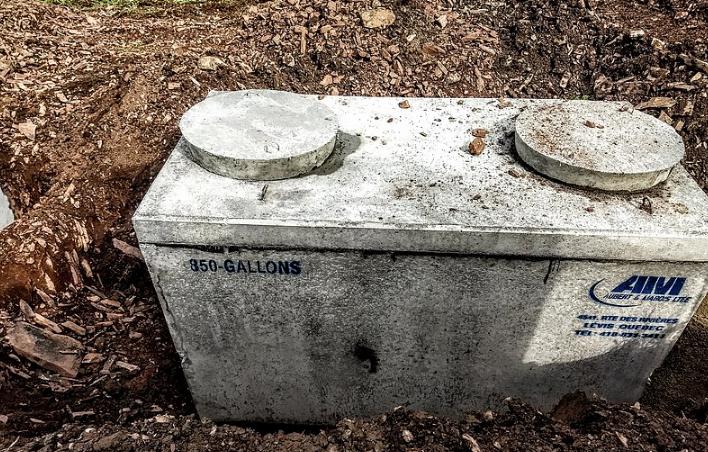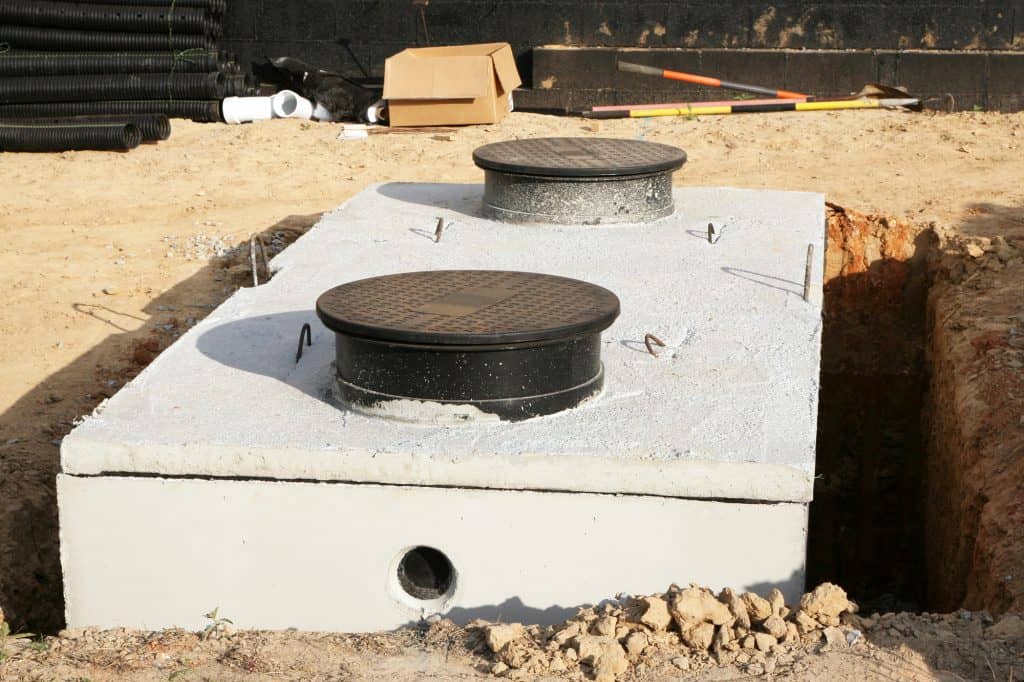We recently discussed how you can build a deck over a manhole or drain, but what about building the same over a septic tank? It’s one thing to leave room for a manhole cover or a drain, or make an accessible hatch, but what does the code say about building a deck over a septic tank?
There are a plethora of questions that may arise in your mind if you have septic tank in your backyard. Can you build a deck over a septic tank? Is it safe? What, if any, dangers does it pose and what to do if you really must build it there?
Usually, building a deck requires that you excavate the area, add dirt, compress it, build a foundation, and then lay your decking on top. If your septic tank is exposed, we wouldn’t recommend building a deck over it. If, however, it is completely underground and you are sure there is no chance of damaging the tank, you can build a deck over a septic tank, but be very careful.
What Is a Septic Tank?

Septic tanks or septic systems are wastewater treatment structures that are normally used in rural areas. Usually, these tanks are situated at a distance from houses, but it’s not uncommon to find some underground tanks near houses where there is constricted space.
These tanks combine nature and science to treat your house’s (or even sometimes the whole neighborhood’s) wastewater flowing through plumbing systems. So, it is natural to assume that these tanks are extremely hazardous for humans, should one get exposed to the gases or water inside.
Usually, septic tanks consist of a tank and a drain-field. These drain-fields are usually soil absorption fields. When sewage water flows into the tank, the organic matter is digested by bacteria within. Oily matter floats while solids settle down.
Soil drain-fields usually direct the water from the tank into several perforated pipes (filtered to ensure no organic matter or solids make their way into the pipes). These pipes are buried in leach fields, chambers, or other units that are designed to ensure that water slowly seeps into the soil.
Alternatively, some septic systems use pumps or gravity to assist the water to seep through sand. Some tanks simply use the same organic matter as filters (peat, sawdust, or foodstuffs, for example). The bacteria within, again, neutralizes any pollutants or disease-causing pathogens.
It isn’t uncommon for most US and UK states, counties, cities, or communities to prohibit building anything over septic system tanks or especially drain fields. If you are looking to build a deck over a septic tank, it is usually a good idea to consult your local environmental agency.
Dangers of Building Over a Septic Tank
The dangers around septic tanks can be divided into two categories; one where you accidentally puncture the tank or pipes and second, where you don’t. The former are active dangers while the latter are passive.
It is important to remember that septic tanks, no matter how technologically advanced they become, are and most likely will continue to be health hazards for human health. This is because of the sewer gases that are trapped within, particularly carbon monoxide (which is a result of bacteria digesting organic matter), can be fatal to humans.
Septic tank poisoning is actually very common. The average lifespan of a septic tank is 15 to 40 years, after which the tank itself starts degrading. When that happens, the gases within start leaking, or worse, the sewage water finds a way out.
This is not only a risk to human health, but also to the environment. There are several diseases that can result directly from exposure to septic tanks:
- Bacterial
- Salmonella
- Shigellosis
- Diarrhea
- trachoma
- Melioidosis
- Viral
- Gastroenteritis
- Hep. A
- Diseases caused by parasites:
- Giardiasis
- Tapeworms
- Threadworms
- Hookworms
These diseases are usually not just limited to one person and can spread to all those around. They can either spread directly or indirectly.
Can You Build a Deck Over a Septic Tank?

If you must build a deck on posts or bricks, we recommend you build a floating deck as we mentioned in our previous article. However, this is only limited to making a deck over a septic TANK, not a drain field. This is because the drain field is absorbing water directly from the tank.
Yes, the water is treated, but that doesn’t mean it’s completely safe.
Floating decks on top of septic tanks usually don’t have much of an effect on the operation of a field unlike making one on top of a drain field. Furthermore, floating decks also reduce the chances of someone falling into the tank, should a deck board give way. Remember to make contingency for broken deck boards, though.
It is very important that you remember that exposure to gases or water from the septic tank is extremely dangerous and can prove to be fatal. If you are simply building a deck that will serve as a ‘walkway’ or just a place to hang out for a while, raise it up and you are good to go.
If, however, you are preparing the deck to build a patio on top of it, we highly recommend you stop.
The reason we are suggesting that floating decks are a better idea (technically, building a floating deck over a septic tank is the lesser of two evils) is because there is generally plenty of air circulation under decks. Don’t raise it too much, just about 6 to 8 feet, and you’ll get sufficient circulation to minimize the damage.
If possible, try to minimize the time you spend on that deck.
Air circulation under the deck will mean that the ground temperature won’t be much of an issue.
The biggest problem you’re likely to face when building a deck over a septic tank is that of compressing dirt; which is why we are recommending raising it. Compressing dirt will mean that you are applying pressure on the septic tank’s pipes, or the tank itself. If it cracks, you are in for a world of trouble – not to mention the fines your county will impose on you.
Another problem you are likely to face is the collapse of a deck board or panel. As we mentioned above, make sure you make a contingency for the same, else your deck is a disaster waiting to happen.
Since you are making your deck at least 6 to 8 feet high, you can attach a heavy duty net under the deck to ensure no one (or nothing) falls through on top of the tank. Another option you have is to build a multi-layered deck. The one below would only be for support, in case the worst happens.
We recommend only building a wooden deck on top of a septic tank. Wood is light and the least likely to put too much pressure on top of your septic tank. And one more thing; this is no place to ‘experiment’, so go with treated wood instead of untreated. If, however, you think untreated wood is too expensive or simply isn’t available, do not forget to stain and seal it.
This will significantly increase the life of the wood, effectively reducing the chance of an accident.
